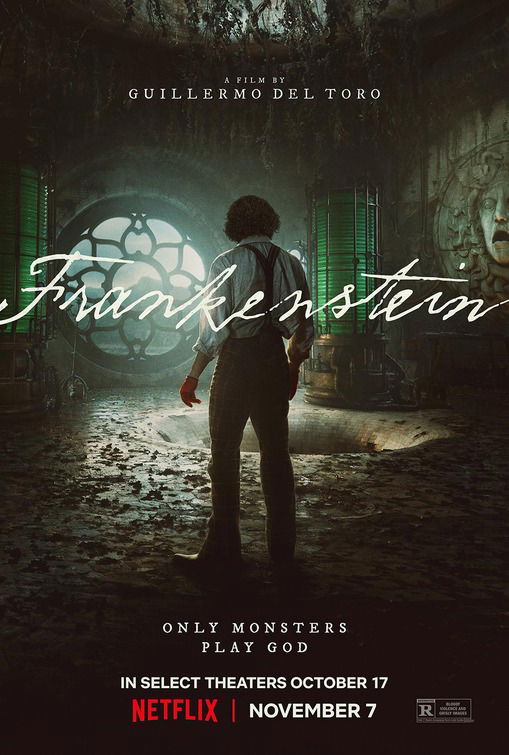“The Healing Power of Forgiveness”

| None | Light | Moderate | Heavy | |
|---|---|---|---|---|
| Language | ||||
| Violence | ||||
| Sex | ||||
| Nudity |
What You Need To Know:
FRANKENSTEIN is a lavish, stylish, powerful and well-acted production. It has many dramatic, exciting and touching scenes, with lots of action. Even better, it has a strong Christian, moral worldview showing the healing power of compassion and forgiveness. Everything leads to a beautiful redemptive ending that’s inspiring and memorable. However, FRANKENSTEIN has lots of strong and very strong violence. The creature attacks people, people shoot the creature, two wolf packs attack animals and people, and Victor Frankenstein assembles bloody body parts. The movie contains images of upper and rear male nudity as well as female nudity when a woman poses nude in a sheer dress. So, MOVIEGUIDE® advises extreme caution.
Content:
Strong Christian, moral worldview promotes compassion and forgiveness, a character undergoes a water baptism, a sacrifice saves a character’s life, the title character sells his soul to a dark angel symbolizing Satan, two characters are symbolically healed by forgiveness at the end of their lives, a character tells another character that since he can’t die he should resolve to live (thus, in a way, forgiveness brings life as well as heals), but title character has a humanist attitude toward science and makes a Faustian deal with the devil (it’s not literal but it’s symbolic in the movie, and the character is haunted by nightmares of a red demonic angel surrounded by the fires of Hell);
One light profanity;
Lots of strong and very strong violence includes creature attacks people (throws and flings them and breaks arms and legs), people shoot the creature, two wolf packs attack animals and people in two scenes, a stick of dynamite explodes, and Victor Frankenstein assembles bloody body parts form battlefields in his laboratory (one scene shows Victor surrounded by blood on the floor and body parts strewn about);
No sex scenes but one character reveals his body has been ravaged by syphilis, the sexual disease;
A nude female model poses for a photographer in a sheer but gauzy wrap that partially exposes her breasts and part of her genital hair and then her full posterior as she walks away, plus images of upper and rear male nudity and the creature, “monster” wears only a loincloth for a time after he’s first created;
Brief alcohol use;
Man smokes in one scene; and,
Two men rob bodies on battlefields, title character defies authorities and God, and both the title character and his creature are consumed by revenge, but compassion and forgiveness overcome that.
More Detail:
The movie opens with the creature pursuing Dr. Frankenstein across the Arctic wasteland. A polar expedition stuck on the ice sees a large explosion in the distance. The captain sends a group of men to investigate, and they find Victor Frankenstein seriously injured from the explosion. They take him back to their ship, but the creature comes after them and demands they give him Victor. The Captain refuses, but the creature starts attacking the men. The creature seems to be getting the best of them, but the men manage to cut open the ice below, and the creature disappears under the water.
Back on the ship, Victor tells the Captain his story. Victor says his father, Baron Frankenstein, was a harsh man who married a rich woman. Baron Frankenstein was often away on business but wanted Victor to become a doctor like him. So, Victor grew up closer to his mother than his father.
Sadly, Victor’s mother died while giving birth to Victor’s brother, William. William resembled the father, but Victor resembled the mother. So, Baron Frankenstein doted on William. Angry about his father’s favoritism, Victor decided to become a more famous doctor than his father.
At this point, the movie depicts Victor as privately making a pact with the Devil to overcome death. He starts to investigate the mysteries of creation.
In the original novel, Mary Shelley purposely left the process by which Victor created life totally vague. However, like many adaptations of FRANKENSTEIN before him, Del Toro’s version uses the idea of electricity, made famous by Universal’s 1931 version with the great Boris Karloff and Colin Clive.
So, Victor discovers a way to use electricity to revive human body parts. He demonstrates this process before the science academy using a brain, torso and right arm. Sure enough, the head and body parts come alive until Victor shuts off the power.
The leaders of the academy call Victor’s invention an abomination and kick him out of their society. However, a wealthy arms merchant, Henrich Harlander, wants to fund Victor’s experiments. He persuades Victor to work with him.
Europe has been ravaged by war for many years. That’s why Harlander has become so wealthy. The ongoing wars also provide a gruesome but great opportunity for Victor to use the fresh bodies of dead soldiers for his creature.
Working with Harlander, Victor learns that his rich benefactor is also the maternal uncle of his brother, William’s, new fiancé, Elizabeth. Victor is smitten with Elizabeth, but she finds Victor’s personality troubling and, ultimately, repulsive.
Victor finally finishes his construction of the creature. However, on the day of his final experiment to bring the creature to life, Harlander comes to him and demands that Victor use his brain for the creature. Victor refuses, because he learns that Harlander’s brain is wracked by a disease that’s also destroying his body. They fight over one of Victor’s machine parts designed to funnel electricity into the creature’s dead flesh.
The rest of the movie details what happens. After bringing the creature to life, Victor is repulsed by the creature’s apparently limited mind. Afraid of the creature’s strength, Victor chains him up. However, when Victor’s brother William comes with his fiancé to visit Victor, Elizabeth’s compassion for the chained-up wretch wakens the creature’s mental capacity.
After she and William leave, Victor decides to destroy the creature. He sets fire to the whole laboratory, but the creature survives. Chased by hunters, the creature finds refuge in an abandoned mill attached to a rustic house. He secretly spies on the people living in the house, which includes a hunter, his wife, their daughter, and daughter’s blind grandfather.
A large pack of wolves invades the farm and destroys many of the family’s chicken, sheep and pigs, but the father manages to fight them off with his gun. The family leaves with the father, who joins up with some other hunters to hunt the wolves and destroy the pack. However, the blind grandfather can’t travel. So, he stays at the farm.
The grandfather catches the creature spying on him. Of course, because of his poor eyesight, the grandfather isn’t scared by the creature’s countenance. The grandfather establishes a friendship with the creature. To spend the time, they peruse the grandfather’s books, and the creature learns to read and get an education. The books include stories, the Bible and Milton.
The rest of the movie tells what happened to the grandfather and how Victor and the creature ended up on the Arctic ice in a life and death struggle.
Guillermo del Toro’s version of Mary Shelley’s FRANKLENSTEIN stars Oscar Isaac as Victor Frankenstein and Jacob Elordi as the creature. It’s a lavish, stylish, powerful, and well-acted production with many dramatic, exciting and touching scenes and lots of action. While there are some scary scenes, horror is not the movie’s sole reason for being. Thus, FRANKENSTEIN is more of a fantastic adventure coupled with a tale of revenge.
Also, Del Toro grew up as Catholic. So, like many similar movies, Del Toro’s FRANKENSTEIN is full of religious themes, including themes of good versus evil, demonic temptation, and even themes of grace. FRANKENSTIEN also has an anti-war theme. Thus, the disease that strikes Victor’s benefactor, a war merchant, is a sign of his corruption, just as Victor’s hatred of his father and his hatred of the creature he makes are signs of Victor’s corruption.
However, the premise of this FRANKENSTEIN rests on the virtues of compassion and forgiveness. Ultimately, both Victor and the creature are healed by a forgiveness generated by compassion. The creature undergoes a water baptism that calms his rage. At another point, the movie also contains an act of sacrifice that saves the creature’s life. In addition, a statue of an angel in Victor’s family home becomes an angry but seductive fallen angel, and Victor’s dreams become haunted by images of that fallen angel surrounded by the flames of Hell. All these things lead to a beautiful redemptive ending that’s inspiring and memorable. In fact, the creature is told that, since he cannot die, the best thing for him to do is resolve to live. Thus, in a way, forgiveness not only heals in this version of FRANKENSTEIN. It also brings true life.
That said, FRANKENSTEIN has many scenes of strong and very strong violence. Those scenes include scenes of the creature attacking people, people shooting the creature, two wolf packs attacking animals and people, and Victor Frankenstein assembling bloody body parts. There’s also a scene where Victor’s rich benefactor reveals his body’s been ravaged by a horrid disease brought about by his profligate lifestyle. A nude female model poses for a photographer in a sheer but gauzy wrap that partially exposes her breasts and part of her genital hair and then her full posterior as she walks away, plus images of upper and rear male nudity and the creature, “monster” wears only a loincloth for a time after he’s first created.
Consequently, MOVIEGUIDE® advises extreme caution.


 - Content:
- Content: 
